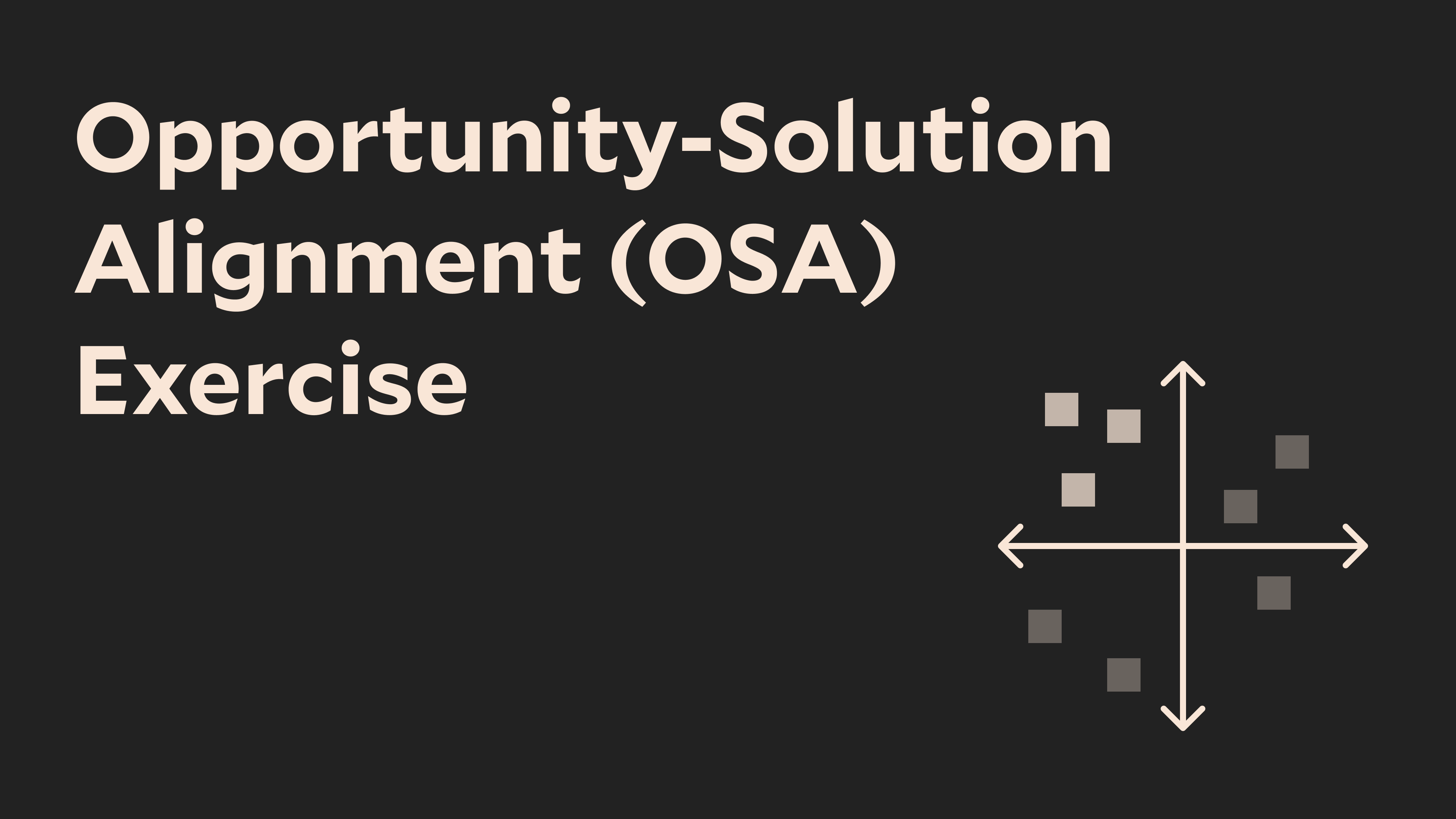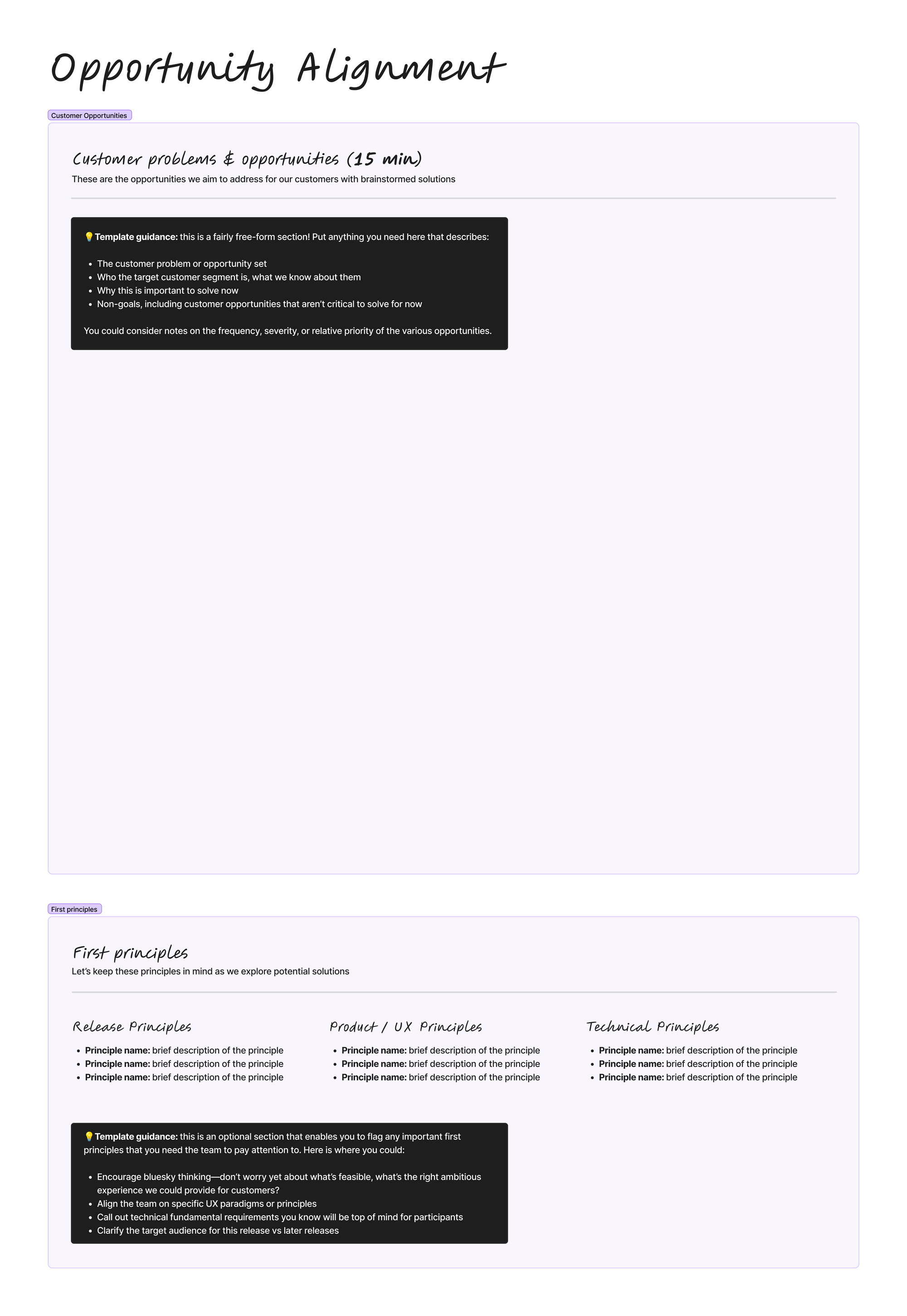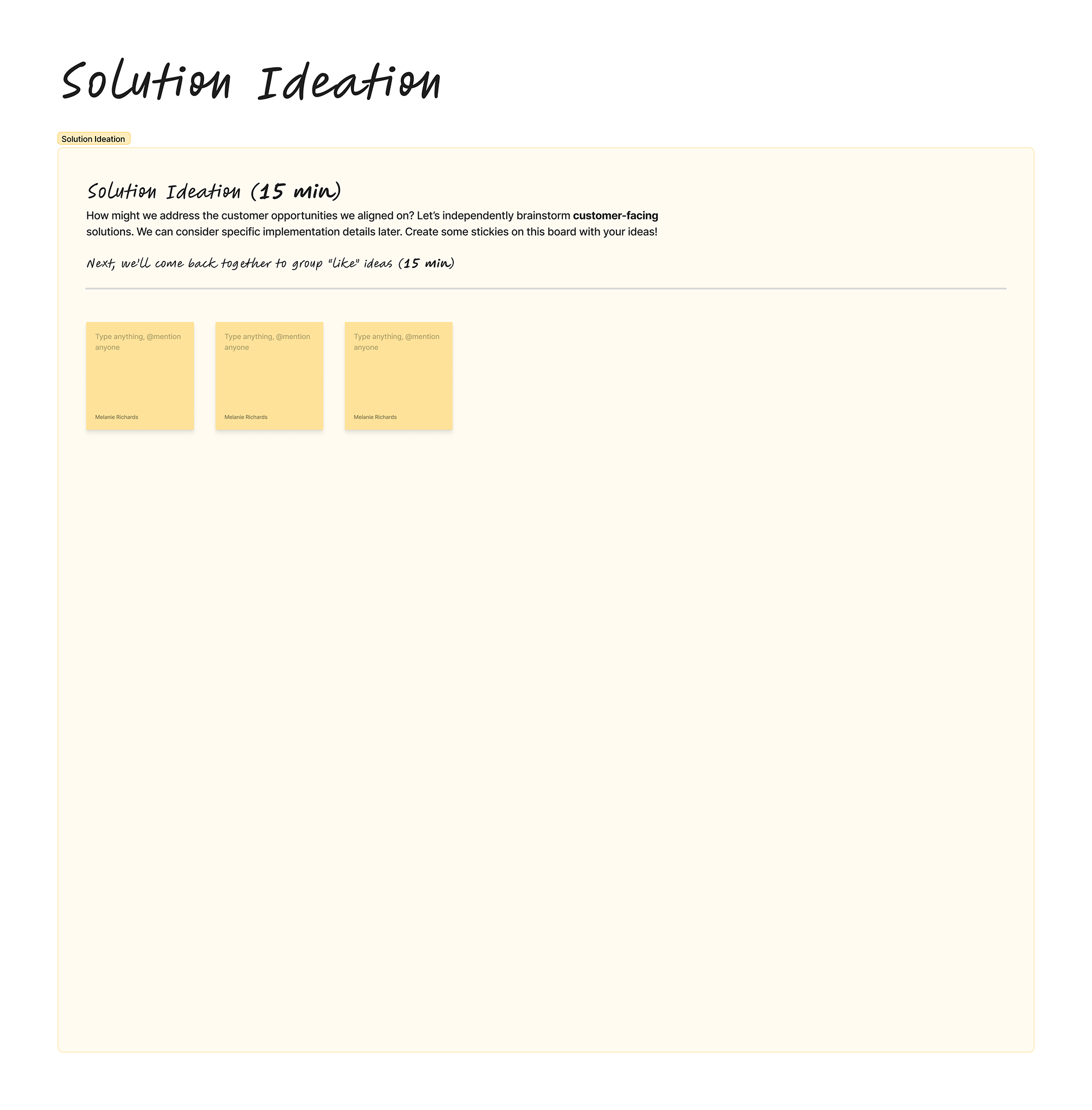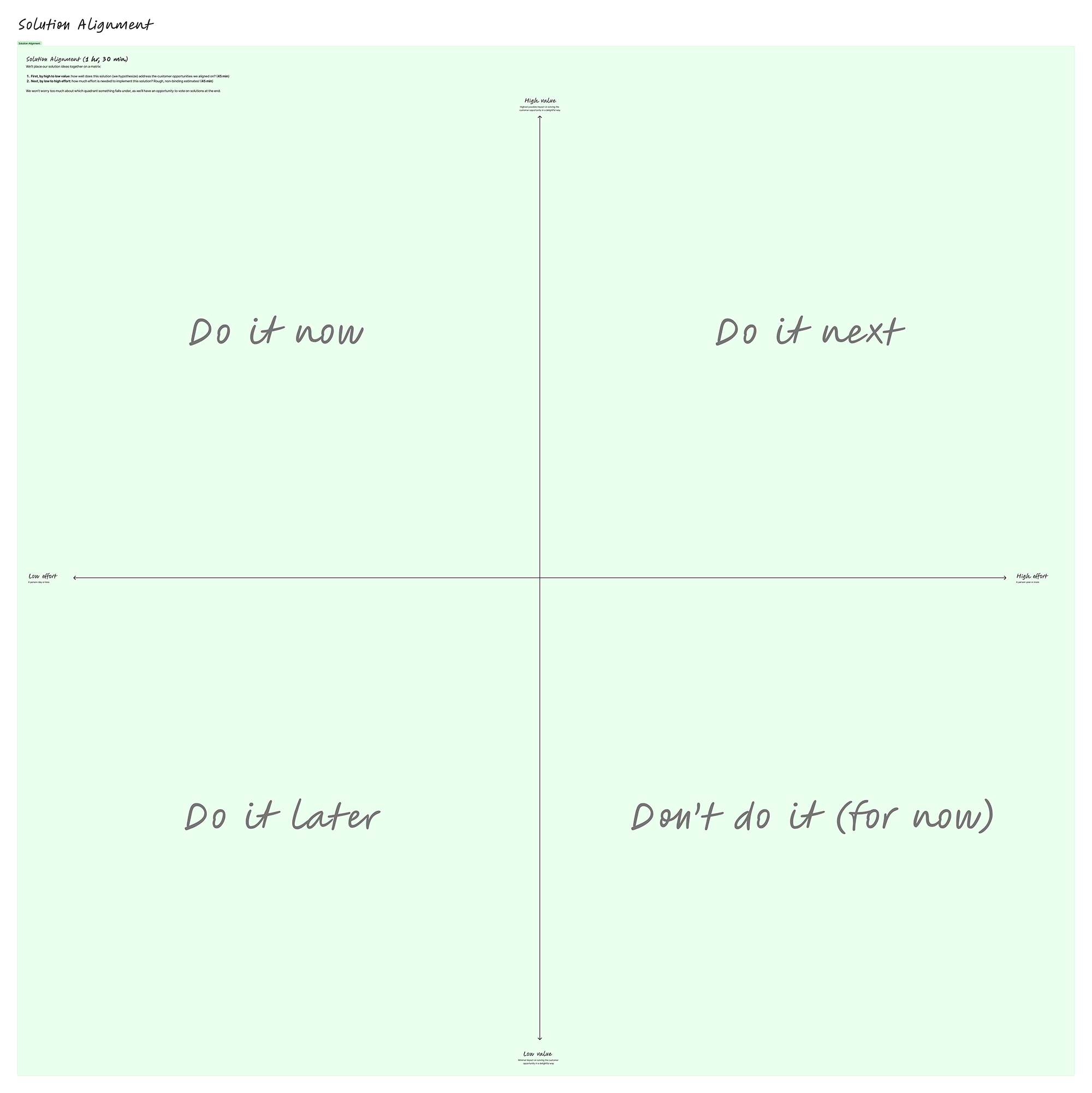Opportunity-Solution Alignment
When I first got into product management, the software development process resembled a Niagara-sized waterfall approach. This may be a familiar story to you: the Product Manager (PM) talks to customers, puts together a thorough product spec, gets that in front of cross-functional peers and stakeholders for review, and so on.
Throwing a fully-featured, bajillion-page spec over the wall doesn’t feel good as a PM, nor as many of said spec’s recipients. I’m so glad that the industry has in many ways embraced a product triad methodology, where Product, Design, and Engineering leads are thought partners in tight collaboration from day one. For product teams who similarly crave a more collaborative working style, I recommend using an Opportunity-Solution Alignment (OSA) exercise to transition from early customer discovery to solution exploration.

What is an OSA?
An Opportunity-Solution Alignment exercise is what it says on the tin: an opportunity to come together as a cross-functional team to:
- Align on a deep, shared understanding of the customer opportunities the team intends to solve for in an upcoming investment—and why those are important to solve for now
- Leverage everyone’s unique perspective to dream up compelling potential solutions to these opportunities
Matt Rinehart first introduced this particular format to the pillar team we both contributed to at Netlify. Fun fact: these exercises were called “Inceptions” at his previous org, but too many folks in had seen the movie Inception to let that name slide. 😉 Whatever you may call these, or whatever format they take, the most important concept is that you collaborate as a cross-functional team as early as possible in discovery phases.
Why use an OSA?
Teamwork makes the dream work! An OSA leverages the entire team’s creativity and unique perspectives to unearth compelling solutions to important customer problems. An engineer might yes-and a designer’s idea with a simple and easily-achieved solution proposal. A product marketing manager could flag a fresh insight from the market.
An OSA also creates a stronger sense of camaraderie and shared ownership. Team members that have a stake in the early direction feel a sense of pride that can translate into customer empathy, attention to quality, a willingness to experiment, and effective collaboration. The early alignment you do as a team enables you to accelerate the pace of decisions throughout the product development lifecycle.
When to use an OSA
Let’s suppose you work at a SaaS company which builds software enabling folks to create and sell their own plushies. Your discrete shippable customer value is delivered as “Releases” organized into a multi-release thematic “Initiative”, which lasts 6-12 months. In between larger Releases, you also ship quality of life improvements and bug fixes.
- ✅ Releases are the best scope of work to explore with OSAs. They’re substantive enough that you’ll have different pathways to explore, without getting totally lost in the weeds.
- ⚠ Initiatives can be explored with an OSA, but you’ll need to structure them more carefully to keep the field of opportunity manageable. You may want to run an OSA at the beginning of an initiative, and later on for a specific release.
- ⚠ Quality of life (QoL) updates are often small enough that they don’t warrant an OSA. However, I have run one for a more substantial QoL where there were multiple valid but mutually-exclusive ways to address the customer problem. In this case, just make the OSA shorter in length and with a smaller guest list.
- ❌ Bugs can be fixed quickly without this ceremony.
Now, let’s get into tactics:
Getting set up
First, take some time to set the context for your team:
- Meet 1:1 with any key folks you need to get on board, such as an Engineering Manager, who sets the tone for their direct reports. Share what you’d like to do with the team, and how it benefits these stakeholders.
- Create pre-reads for participants. This includes prepping the OSA materials, as well as a Loom walkthrough or similar introduction to the concept.
Securing buy-in
If you work in an organization where some functions aren’t accustomed to this type of early discovery and ideation, you’ll generally get one of two responses:
- “This is awesome, let’s do it!” 🙌
- “I don’t know, does this mean {function} is responsible for coming up with the solutions? Isn’t that the PM’s job?” These are fair questions!
My experience has been that skeptical peers tend to love the approach once they try their first OSA: it becomes tangibly obvious that they have a seat at the table, and that their perspective matters. Beforehand, I find it’s helpful to frame the exercise as a pilot—something to try out. You could assure your peer that the PM is ultimately responsible for the outcomes of the OSA, but that you value everyone’s point of view and believe the team can generate some creative solutions together.
Assembling your team
- At a minimum, an OSA should include the core product trio: product manager, designer, engineering manager, and any tech leads for the project. Ideally, invite other key contributors, such as other engineers who will work on this project.
- You can then get creative with the invite list! At one or another OSA, I’ve invited product marketing managers, solution/sales engineers, technical support pros, docs writers, data scientists, researchers, stakeholders, and so on. Anyone who you know to have unique perspective or insight on the opportunity space could be included.
- Be careful to keep the list manageable though! Probably ~10 people is a reasonable maximum.
Making the time
At 2–3 hours, an OSA can be a notable time commitment. There are a few tactics you can employ to make this a lighter lift:
- Trial an OSA for your more impactful and nebulous Releases. Generally, a Release kickoff likely happens infrequently enough that this time commitment isn’t so disruptive anyway.
- Break the OSA up into smaller sessions (in my template I suggest two sessions).
- Reduce the time spent on a particular step. The estimates in the template are on the longer side.
- Take advantage of async time to share opportunity context or request input.
- When scheduling an OSA, optimize for a smaller handful of required participants’ calendars. You could consider using time slots for existing ceremonies (such as a team meeting).
Ultimately though, a couple hours of alignment early in a project can save you exponential amounts of time spinning your wheels and creating team alignment throughout the software development lifecycle. That’s a worthwhile investment in your shared success.
How to run an OSA
First off, I’ve created a Figma Community Template for OSAs, which you are welcome to use for these brainstorming exercises!
Session 1
Step 1: Opportunity Alignment

Before the OSA begins, the driver—often the PM—should gather context on the customer opportunity space. The materials you create are specific to the problem space, but should include:
- The customer problem or opportunity set
- Who the target customer segment is, what we know about them
- Why this is important to solve now
- Non-goals, including customer opportunities that aren’t critical to solve for now
You could consider notes on the frequency, severity, or relative priority of the various opportunities. Include a summary of supporting user research or data insights.
Share these materials as a pre-read. Walk through them together live and prompt for questions, additional insights, and discussion. From this step, everyone should have a good sense of what you’re aiming to achieve.
Step 2: Solution Ideation

Set a timer for 15 minutes and ask participants to generate some customer-facing solutions to the aligned-upon customer opportunity set. Encourage folks not to worry about implementation details yet—though these stickies will almost certainly creep into the brainstormed solutions!
Step 3: Solution Grouping
Once brainstorming time is up, ask participants to quietly group the ideas into “like” groups. Folks can come off mic to ask each other clarifying questions. In the past I’ve done this part live with the group, but have found we can do it faster if we all chip in rather than going sticky by sticky.
That’s it for session 1! You can encourage participants to add more stickies in between sessions if another idea pops up in the meantime.
Session 2
Step 4: Solution Alignment — Value

As a team, place your sticky groups vertically on a matrix, from high to low value. This should be an objective discussion: how well do you hypothesize the idea would solve the customer opportunity in a delightful way? Highest impact on the opportunity = highest value. Feasibility or level of effort is not a factor now—we’ll get to that next.
- Remind participants there are no bad ideas. We’re assessing fitness of the solution to the aligned opportunities—not critiquing individuals.
- Some ideas may be intriguing but wouldn’t have direct impact on the opportunity set. Place these in the parking lot, along with implementation details, product fundamentals, etc.
- There should be no stickies at equal height, or on the horizontal axis. Be honest about their relative priority! You may find that you move some stickies up or down as you go through this exercise.
Step 5: Solution Alignment — Effort
As a team, move your sticky groups horizontally on the matrix, from low to high effort.
- Remind the team these are very rough estimates—we are not asking for ETAs, and we’ll expect actual effort to change based on additional discovery work.
- Effort is again relative. In the template, I’ve labeled the lowest effort as “a person-day or less”, and highest effort as “a person year or more”. This is just to give some bounds to the conversation—adjust to whatever language resonates with your team.
- At this point, folks may notice something they care about is not ending up in the “do it now” quadrant. Don’t panic! A vote is coming up next.
Step 6: Voting Exercise
Once all your stickies are in place on the matrix, lead the team in a ~10 minute voting exercise. Everyone gets 3 👍 and 3 👎. The point of this exercise is to express enthusiasm for something that might be further down the priority list—or disagreement that a solution should be explored further.
- Participants can use allocate these votes however they like, such as three thumbs up on an idea they feel very strongly about.
- There is no need to use a thumbs up in the “Do it now” quadrant—these are already solutions the team is likely to explore further. Instead, use these to advocate for ideas in another quadrant that you think should be explored now. The main questions this vote probes for:
- Any solutions not falling under “do it now” that we want to explore?
- Any solutions under “do it now” that could be deferred?
Once voting is complete, take a few minutes to discuss the outcomes as a team—then wrap up the OSA with next steps!
Outcomes and next steps
Teams that go through an OSA should now be aligned on the customer opportunity space, and have a good sense of solutions they’d like to explore further. From here:
- The PM should share a summary of the high-priority solutions the team aligned on, potentially in a product requirements document (PRD). This exercise may not end in full consensus—you may need to make judgement calls.
- The cross-functional team can now explore the solution ideas further with design mocks, prototypes, usability testing, customer interviews, etc.
- If something new and compelling pops up during further discovery—or customers aren’t responding well to the solutions—pay attention to these insights! Pivot your approach as needed and discuss this evolution continuously as a cross-functional team.
Parting thoughts
Opportunity-Solution Alignment exercises are a worthwhile investment in a cross-functional team’s success. Use OSAs to create clarity on important customer opportunities, and to generate creative solutions to these opportunities. Please try it out with your team and let me know how it goes!
And a shameless plug: if you want to empower web makers alongside collaborative peers with strong customer empathy chops, we’re hiring at Webflow!